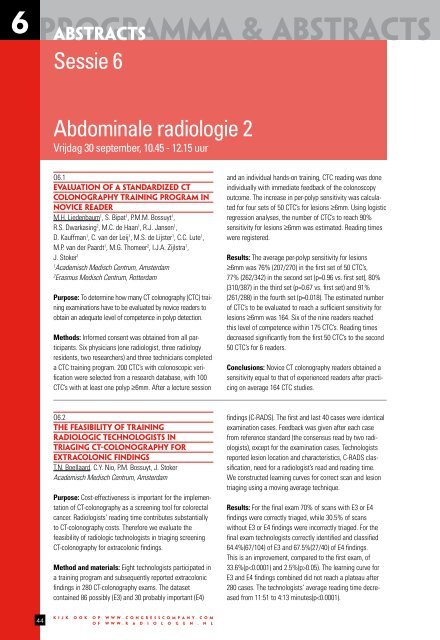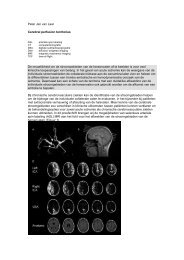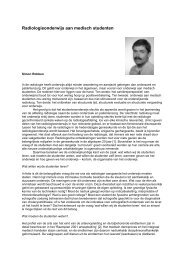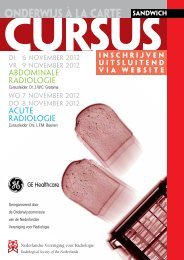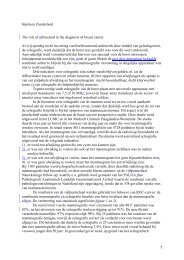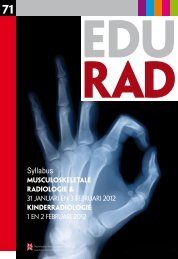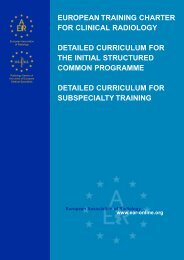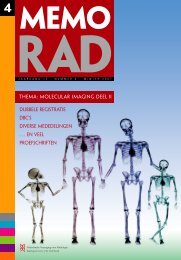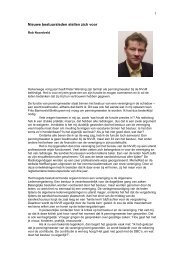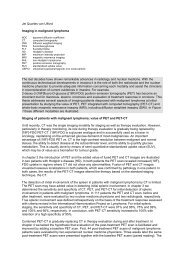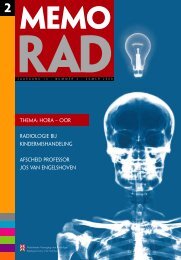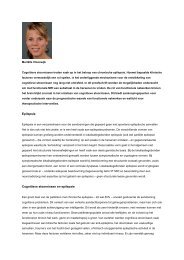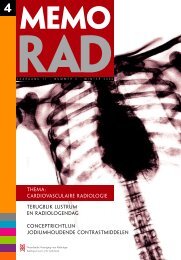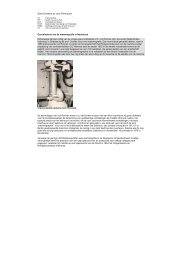programma & abstracts - Nederlandse Vereniging voor Radiologie
programma & abstracts - Nederlandse Vereniging voor Radiologie
programma & abstracts - Nederlandse Vereniging voor Radiologie
You also want an ePaper? Increase the reach of your titles
YUMPU automatically turns print PDFs into web optimized ePapers that Google loves.
6<br />
<strong>programma</strong> <strong>abstracts</strong> & <strong>abstracts</strong><br />
Sessie 6<br />
Abdominale radiologie 2<br />
Vrijdag 30 september, 10.45 - 12.15 uur<br />
O6.1<br />
EVALUATION OF A STANDARDIZED CT<br />
COLONOGRAPHY TRAINING PROGRAM IN<br />
NOVICE READER<br />
M.H. Liedenbaum 1 , S. Bipat 1 , P.M.M. Bossuyt 1 ,<br />
R.S. Dwarkasing 2 , M.C. de Haan 1 , R.J. Jansen 1 ,<br />
D. Kauffman 1 , C. van der Leij 1 , M.S. de Lijster 1 , C.C. Lute 1 ,<br />
M.P. van der Paardt 1 , M.G. Thomeer 2 , I.J.A. Zijlstra 1 ,<br />
J. Stoker 1<br />
1<br />
Academisch Medisch Centrum, Amsterdam<br />
2<br />
Erasmus Medisch Centrum, Rotterdam<br />
Purpose: To determine how many CT colonography (CTC) training<br />
examinations have to be evaluated by novice readers to<br />
obtain an adequate level of competence in polyp detection.<br />
Methods: Informed consent was obtained from all participants.<br />
Six physicians (one radiologist, three radiology<br />
residents, two researchers) and three technicians completed<br />
a CTC training program. 200 CTC’s with colonoscopic verification<br />
were selected from a research database, with 100<br />
CTC’s with at least one polyp ≥6mm. After a lecture session<br />
and an individual hands-on training, CTC reading was done<br />
individually with immediate feedback of the colonoscopy<br />
outcome. The increase in per-polyp sensitivity was calculated<br />
for four sets of 50 CTC’s for lesions ≥6mm. Using logistic<br />
regression analyses, the number of CTC’s to reach 90%<br />
sensitivity for lesions ≥6mm was estimated. Reading times<br />
were registered.<br />
Results: The average per-polyp sensitivity for lesions<br />
≥6mm was 76% (207/270) in the first set of 50 CTC’s,<br />
77% (262/342) in the second set (p=0.96 vs. first set), 80%<br />
(310/387) in the third set (p=0.67 vs. first set) and 91%<br />
(261/288) in the fourth set (p=0.018). The estimated number<br />
of CTC’s to be evaluated to reach a sufficient sensitivity for<br />
lesions ≥6mm was 164. Six of the nine readers reached<br />
this level of competence within 175 CTC’s. Reading times<br />
decreased significantly from the first 50 CTC’s to the second<br />
50 CTC’s for 6 readers.<br />
Conclusions: Novice CT colonography readers obtained a<br />
sensitivity equal to that of experienced readers after practicing<br />
on average 164 CTC studies.<br />
O6.2<br />
THE FEASIBILITY OF TRAINING<br />
RADIOLOGIC TECHNOLOGISTS IN<br />
TRIAGING CT-COLONOGRAPHY FOR<br />
EXTRACOLONIC FINDINGS<br />
T.N. Boellaard, C.Y. Nio, P.M. Bossuyt, J. Stoker<br />
Academisch Medisch Centrum, Amsterdam<br />
Purpose: Cost-effectiveness is important for the implementation<br />
of CT-colonography as a screening tool for colorectal<br />
cancer. Radiologists’ reading time contributes substantially<br />
to CT-colonography costs. Therefore we evaluate the<br />
feasibility of radiologic technologists in triaging screening<br />
CT-colonography for extracolonic findings.<br />
Method and materials: Eight technologists participated in<br />
a training program and subsequently reported extracolonic<br />
findings in 280 CT-colonography exams. The dataset<br />
contained 86 possibly (E3) and 30 probably important (E4)<br />
findings (C-RADS). The first and last 40 cases were identical<br />
examination cases. Feedback was given after each case<br />
from reference standard (the consensus read by two radiologists),<br />
except for the examination cases. Technologists<br />
reported lesion location and characteristics, C-RADS classification,<br />
need for a radiologist’s read and reading time.<br />
We constructed learning curves for correct scan and lesion<br />
triaging using a moving average technique.<br />
Results: For the final exam 70% of scans with E3 or E4<br />
findings were correctly triaged, while 30.5% of scans<br />
without E3 or E4 findings were incorrectly triaged. For the<br />
final exam technologists correctly identified and classified<br />
64.4%(67/104) of E3 and 67.5%(27/40) of E4 findings.<br />
This is an improvement, compared to the first exam, of<br />
33.6%(p0.05). The learning curve for<br />
E3 and E4 findings combined did not reach a plateau after<br />
280 cases. The technologists’ average reading time decreased<br />
from 11:51 to 4:13 minutes(p


